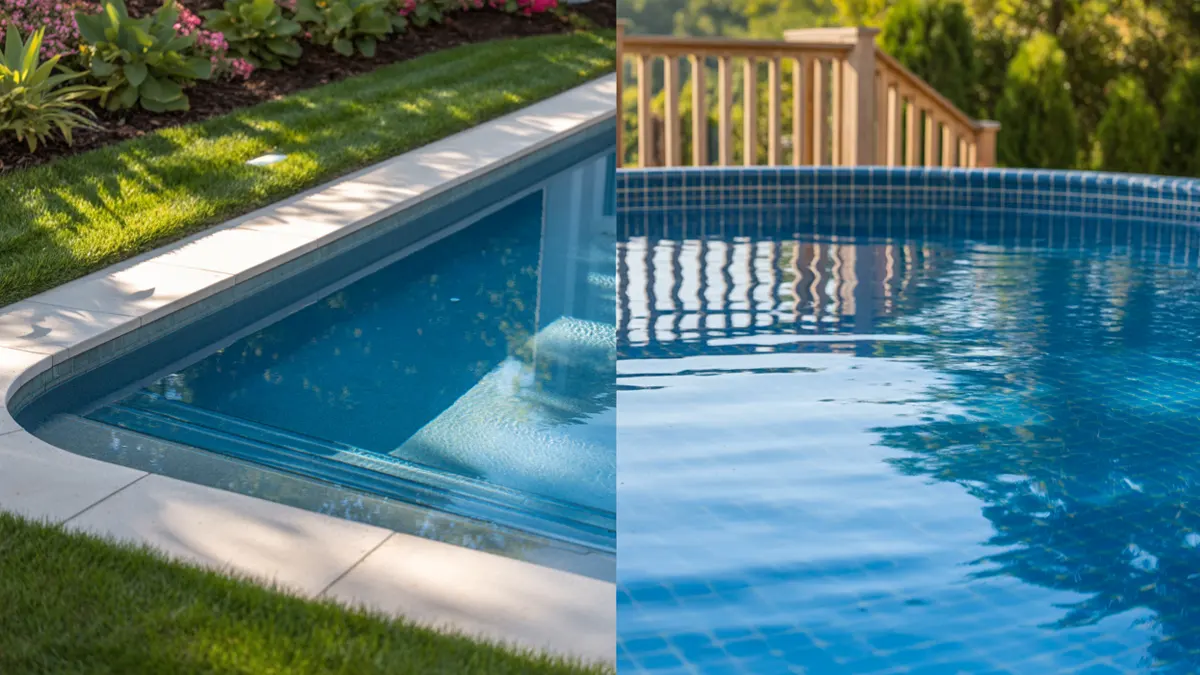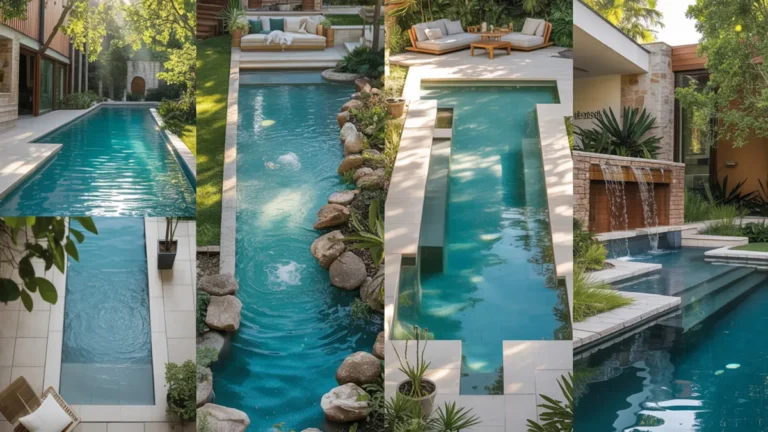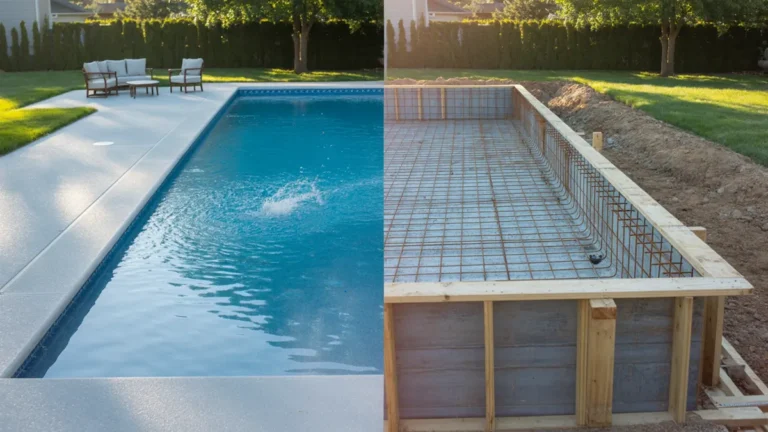Deciding on a backyard pool involves more than picturing lazy summer afternoons; it requires weighing budget, aesthetics, maintenance, and future mobility. Two options dominate homeowner discussions: permanent in-ground installations and versatile above-ground models.
Each brings distinct advantages, and the better choice rests on how you plan to use the space and the resources you can invest. The comparison below lays out the key factors in clear, practical language.
Installation and Flexibility
Timeline and Disruption
Constructing an in-ground pool is essentially a building project. Excavators arrive, soil is hauled away, concrete or fiberglass shells are set, and decking or landscaping finishes the perimeter. Even under ideal conditions, completion can stretch from one month to an entire season.
Above-ground kits, on the other hand, assemble in days rather than weeks. Many homeowners manage the installation over a dedicated weekend with help from friends. The rapid turnaround minimizes disruption and offers immediate use once water chemistry is balanced.
Portability
An in-ground pool is, by design, immovable; it may enhance property value, yet it ties leisure activities to one address. If relocation looms in the next few years, permanence becomes a drawback.
Above-ground pools provide flexibility. Most steel-frame or resin models can be dismantled and transported to a new residence, preserving the initial investment for families who anticipate a move.
Aesthetics and Customization
Design Scope
The design freedom of an in-ground installation is broad. Owners may specify free-form lagoons, sleek lap lanes, integrated spas, or vanishing edges. Waterfalls, color-changing lights, and mosaic tile create a custom look that unites architecture with landscape. Homeowners seeking custom pool design ideas can explore fresh concepts that elevate any backyard retreat.
Above-ground choices are more standardized—usually round or oval with heights of forty-eight or fifty-four inches. Even so, thoughtful decking, privacy screens, and strategic plantings convert a plain structure into an inviting focal point.
Visual Impact
Because in-ground pools sit flush with surrounding terrain, they typically complement hardscape and planting schemes seamlessly. Real-estate professionals frequently list them as premium amenities in warm-weather markets.
An above-ground pool is naturally more prominent; its walls rise several feet above grade. Skilled carpentry and tasteful accessories soften the outline, yet the look remains distinct from an in-ground alternative.
Cost Considerations
Up-Front Investment
In-ground pools represent a sizable capital outlay. Excavation, structural materials, plumbing, and permits commonly push the initial price from the mid-thirty-thousands into low six figures. For many households, that figure alone decides the matter.
By contrast, above-ground pools start around a thousand dollars and seldom exceed the cost of a family sedan. The lower barrier makes them attractive to first-time pool owners or anyone testing whether a permanent aquatic feature truly fits their lifestyle.
Ongoing Expenses
A pool’s real price tag emerges over time. In-ground systems have greater water volume, more elaborate filtration, and, often, energy-hungry accessories such as lighting or automated cleaners. Annual upkeep can climb beyond two thousand dollars once chemicals, electricity, and periodic professional servicing are included.
Smaller, simpler above-ground units usually cost less to run; however, vinyl liners must be replaced every five to ten years, and winterizing in freezing climates demands diligence. While yearly costs are lower, long-term ownership still calls for a realistic maintenance budget.
Durability and Lifespan
Concrete and fiberglass in-ground shells can endure for multiple decades when water chemistry stays within recommended ranges. Concrete surfaces do require refinishing roughly every fifteen years, while fiberglass models resist staining and algae yet offer fewer shape options.
Above-ground pools usually last seven to fifteen years, depending on material quality and climate. Corrosion, ultraviolet exposure, and liner punctures dictate replacement intervals. For owners comfortable with periodic upgrades, the shorter lifespan may be an acceptable trade-off.
Maintenance Requirements
In-ground pools involve larger pumps, multiple returns, and, frequently, automated cleaners. Weekly tasks include skimming, brushing, vacuuming, and testing water balance. Some owners delegate the routine to professional service companies, adding to operational costs but saving valuable time. For those seeking a balance between aesthetics and practicality, working with specialists such as Outdoor Visual Werks can ensure pool installations are both beautiful and manageable over the long term.
Above-ground pools, with their smaller surface area, simplify these chores. Manual vacuuming or cartridge filters often suffice, and closing procedures before winter can be completed in an afternoon. Still, neglect invites algae blooms just as quickly as it does in a resort-style installation.
Safety and Accessibility
Safety regulations for in-ground pools are strict in most jurisdictions: barriers, self-closing gates, and alarms mitigate accident risk. Steps and shallow sections improve accessibility, yet continuous supervision remains essential.
Elevated walls give above-ground pools an inherent safety advantage; unauthorized entry is harder, especially if the ladder is removed between uses. Optional locking steps or perimeter fencing add another layer of protection for households with children or pets.
Climate and Seasonal Factors
In regions blessed with mild winters, an in-ground pool provides year-round enjoyment and often becomes the home’s social hub. Conversely, in snow-prone zones, owners must budget for professional closing services or risk freeze damage.
Above-ground pools cater well to short swimming seasons. Owners can drain and store major components indoors, shielding liners and hardware from ice-and-thaw cycles that shorten service life.
Make Your Decision
Selecting between an in-ground and an above-ground pool is ultimately a question of priorities. Homeowners committed to their property, equipped with ample funds, and interested in bespoke design typically gravitate toward in-ground construction. Those seeking affordability, rapid installation, and future flexibility often find above-ground models align better with their objectives.
If you’d still like expert guidance, Outdoor Visual Werks offers design consultation and project management services that will streamline the process and ensure your pool blends seamlessly with the surrounding landscape.




